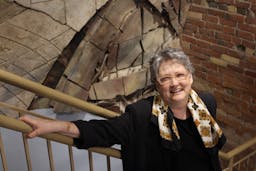To Uganda, With Love
Apr 28, 2022
Story
There are no boundaries -- geographical or otherwise -- when it comes to violence against women.
There are also no limits to the power of art to comfort and heal.
Myria Rei Sólas, an art and play therapist in Peterborough, Canada discovered both these realities when she spent two weeks in January, 2017, in the village of Amor, near Entebbe, Uganda on a trip arranged by Red Pencil International, a humanitarian organization that uses art therapy and conducts volunteer missions around the world.
The purpose of Myria's assignment was to work with women and girls who had experienced domestic violence. It was a three-trip commitment, and she returned to the same village in May and September of the same year.
"Domestic violence is rampant throughout the country," she explained. "There's still an attitude that women are property, so they can be treated however the men wish. If women displease them, then that's reason enough to be beaten."
"There's also issues around birth control as well," she continued. "It's an honourable thing to have many children, but if women choose not to do so, and the husband finds out they are using birth control, they can be beaten."
"It was so exciting to see the women start to come alive by doing this."
Myria is an artist in "a little of everything", mainly acrylic paint and mixed media, but she also makes jewellery and sculptures and does weaving, felting and quilting.
“As long as I can remember I’ve done some kind of art. It’s always been a way of expression of for me. It makes me feel happy.”
Myria, 49, grew up in Scarborough and moved to Peterborough 30 years ago to attend Trent University, where she obtained a degree in philosophy and English. After marriage and three children, now aged 26, 17 and 15, she returned to school and received a joint Master’s degree in counselling psychology and art therapy. She now works in Peterborough as a psychotherapist, art and play therapist, and counsels people of all ages – children, youth and adults — incorporating play and art into therapy.
In the past, she has volunteered with Hospice Peterborough working with grieving children and at present is volunteering with a palliative care patient. For over 20 years, she volunteered teaching parenting classes with the Peterborough Health Unit’s “Nobody’s Perfect” program.
But she had never volunteered for anything like the Ugandan trip.
"It's something I've always wanted to do. It was rewarding to go and do this and I probably got out as much going there as what I offered, at least as much," she said. "I have a clearer picture of what the rest of the world is like, how many people live with so much more hunger and poverty than I ever knew, and how important water is."
She said, even though the women and girls have so little, they have great spirit with strong values, and they work hard and care about each other. When Myria became sick, community members went "above and beyond their duty with complete compassion"to care for her
"They still have hope and they are good, resilient people," she said.
While in Uganda, Myria worked in the community school, along with another volunteer therapist, with a group of women and a group of girls -- a little over 80 females in all -- some of whom had walked miles to get there. The women were victims of violence and the girls, some as young as seven, had witnessed a parent being hurt.
One activity involved drawing a picture of mountains and valleys -- the highs and lows of life -- and then sharing their emotions.
"One of the interesting things about the women's group was that many had never been to school or in a classroom, and had never used a pencil," said Myria. "At first the older ones were anxious about what to put on paper."
"But we explained that it wasn't about creating masterpieces or comparing to others. It was about expressing feelings or learning about themselves, so then they got that."
"It was so exciting to see the women start to come alive by doing this," she said. "There's some cultural things around talking about a negative experience. I found the girls especially had a hard time talking about anything that was difficult, or sad, or painful. There's an expectation that they should be happy and smiling all the time."
They also made paper masks with the girls. The fronts were collages of who they were on the outside -- things people knew about them. On the backs, the collages expressed who they were on the inside.
"There were themes I could see in everyone's art, and they were survival themes," said Myria. "On the first day they were asked to draw pictures of what was important to them. Nearly everyone had similar images -- churches, God, families, flowers, chickens and shade. But the women walked miles every day to get water, and it was water that was most evident in their work. It was most important to them, and it was a major eye opener for me to see how blessed we are here."
Myria feels strongly that art and creativeness has a place in helping people.
"It can be a wonderful tool for self-expression, healing, change and self-awareness," she said. "The main thing about the work for me is just to be present for people to support them and really listen. The same thing was true in Uganda, during the groups. What I feel was offered was bearing witness to the women and their experiences, helping them have a voice and empowering them."
By Melodie McCullough




